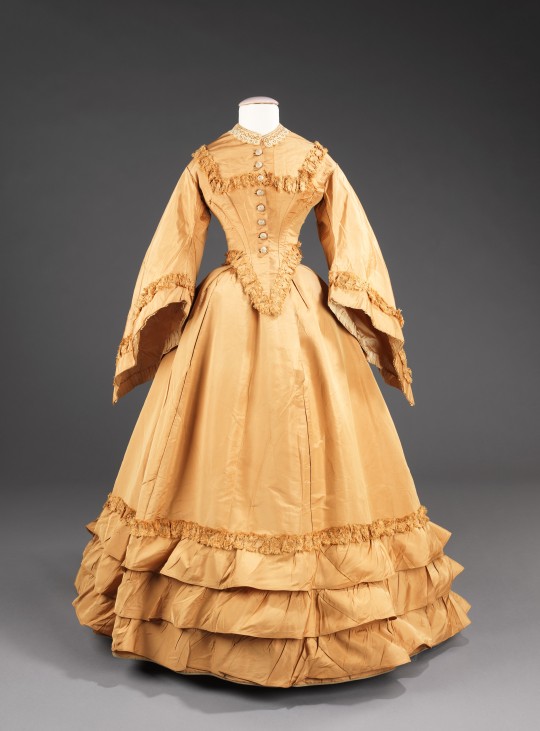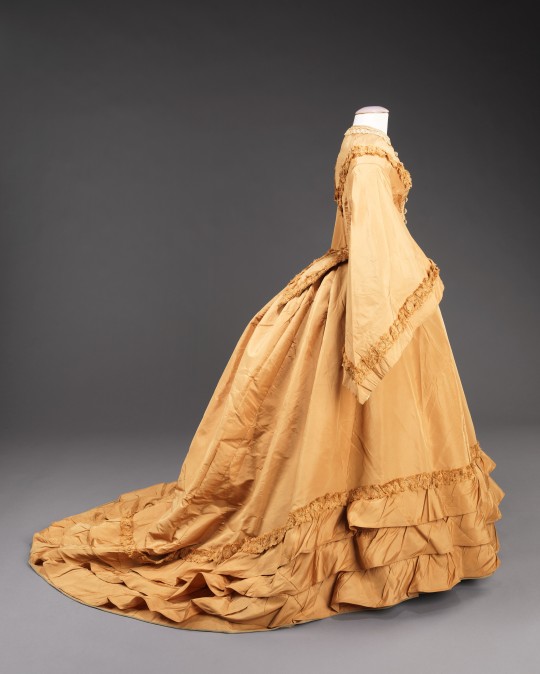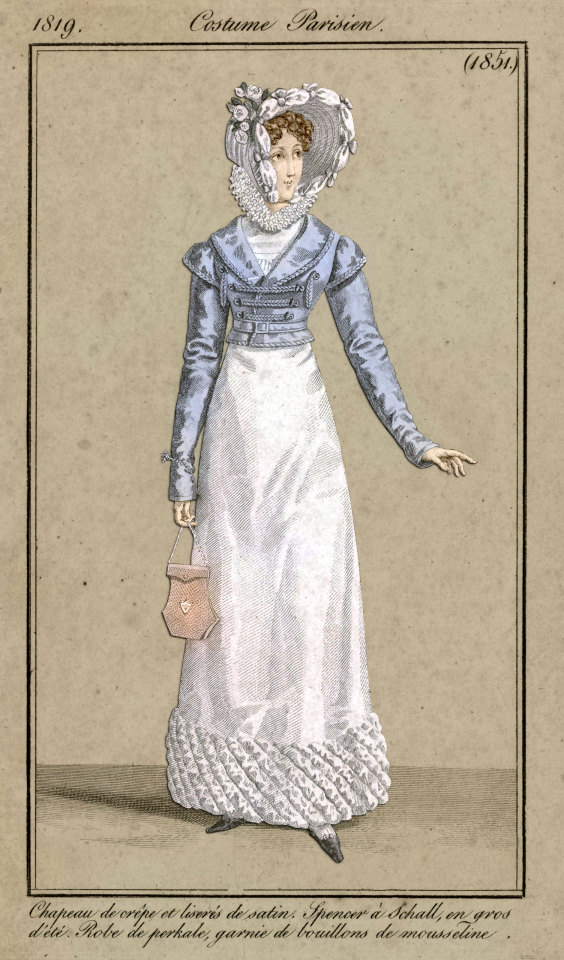#1851 fashion
Explore tagged Tumblr posts
Text



• Mule.
Place of origin: England
Date: ca. 1851
Medium: Silk brocade, leather
#fashion history#history of fashion#fashion#19th century fashion#19th century#19th century shoes#shoes#mules#mule#silk brocade#ca. 1851
199 notes
·
View notes
Text

submitted by @edwardian-girl-next-door 💚🩵
#historical fashion poll submission#historical fashion polls#fashion poll#historical dress#historical fashion#dress history#fashion history#fashion plate#19th century#19th century fashion#19th century dress#mid 19th century#1850s dress#circa 1850#1850s fashion#1850s#1851#skirt
114 notes
·
View notes
Text

The World of Fashion, February 1851
#1851#1850s#history#fashion#fashion history#historical#historical fashion#1850s fashion#1850s dress#victorian#victorian era#victorian fashion#victorian dress#victorian aesthetic#1850s art#history tag#fashion plate#dress#19th century#19th century fashion#19th century dress#19th century art#mid 19th century#1800s#1800s fashion#mid 1800s#1800s dress#1800s aesthetic#antique#antiquebee
208 notes
·
View notes
Text

Musée des Familles, v. 35, plate 70, September 1851. Digital Collections of the Los Angeles Public Library
#Musée des Familles#19th century#1850s#1851#periodical#fashion#fashion plate#color#lapl#dress#fichu#mantle#september color plates
11 notes
·
View notes
Text

4 notes
·
View notes
Text
Budgeting, What's ?
Write about your approach to budgeting. There is no approach , I am very bad with my budgeting skill. Hopefully I am gradually learning some things new and try to apply that for my budget. Take Care! Smile Always! Stay Happy and Healthy! Pray!
View On WordPress
#act now#action#Affiliate marketing#budget#dailyprompt#dailyprompt-1851#Iqra Fashions#learn#life quote quotes#skill#Yuva Home Tutors
0 notes
Text
NMACC showcase: From beetle wings to chintz, India’s gift to global fashion
Special commissions from Rahul Mishra | Photo Credit: Mitsun Soni A little over 150 years ago, over 30,000 hand cut and mounted samples of Indian textiles were painstakingly organised into an album series to educate and inspire commercial and design industries in India and Britain. Its creator, John Forbes Watson, called them ‘trade museums’. Watson would have been pleased to walk around the…
View On WordPress
#Alexander McQueen Plato’s Atlantis#Anamika Khanna#archival inspirations to contemporary times#armadillo boots#armadillo dress#Bollywood costumes#chanel#Chintz#curator Hamish Bowles#dior#Exhibition Design Director Patrick Kinmoth#Great Exhibition of London 1851#impact that India has had on western fashion#India in Fashion#Indian fashion#India’s impact on the global fashion#Metropolitan Museum#Mughal gardens#New York#nita ambani#nmacc#Rahul Mishra#Ritu Kumar#Sternocera ruficornis#the Royal Ontario Museum#yves saint laurent
0 notes
Text
121 Words & Phrases for Dying
A remarkable creativity surrounds the vocabulary of death. The words and expressions range from the solemn and dignified to the jocular and mischievous.
Old English
swelt/forswelt ⚜ give up the ghost ⚜ dead ⚜ i-wite
wend ⚜ forworth ⚜ go out of this world ⚜ quele ⚜ starve
c.1135 — 1600s
die (c.1135) ⚜ fare (c.1175) ⚜ end; let; shed (one’s own) blood (c.1200)
yield (up) the ghost (c.1290) ⚜ take the way of death (1297)
die up; fall; fine; leave; spill; tine (c.1300)
leese one’s life-days (c.1325) ⚜ part (c.1330)
flit (c.1340) ⚜ trance; pass (1340) ⚜ determine (c.1374)
disperish (c.1382) ⚜ be gathered to one’s fathers (1382)
miscarry (c.1387) ⚜ go; shut (1390)
expire; flee; pass away; seek out of life; sye; trespass (c.1400)
decease (1439) ⚜ ungo (c.1450) ⚜ have the death (1488)
vade (1495) ⚜ depart (1501) ⚜ pay one’s debt to nature (c.1513)
galp (1529) ⚜ go west (c.1532) ⚜ pick over the perch (1532)
die the death (1535) change one’s life; jet (1546)
play tapple up tail (1573) ⚜ inlaik (1575) ⚜ finish (1578) ⚜ relent (1587)
unbreathe (1589) ⚜ transpass (1592) ⚜ lose one’s breath (1596)
go off (1605) ⚜ make a die (of it) (1611) ⚜ fail (1613)
go home (1618) ⚜ drop (1654) ⚜ knock off (c.1657) ⚜ ghost (1666)
go over to the majority (1687) ⚜ march off (1693)
bite the ground/sand/dust; die off; pike (1697)
1700s — 1960s
pass to one’s reward (1703) ⚜ sink; vent (1718) ⚜ demise (1727)
slip one’s cable (1751) ⚜ turf (1763) ⚜ move off (1764)
kick the bucket (1785) pass on (1805) exit (1806)
launch into eternity (1812) ⚜ go to glory (1814) ⚜ sough (1816)
hand in one’s accounts (1817) ⚜ croak (1819)
slip one’s breath (1819) ⚜ stiffen (1820) ⚜ buy it (1825)
drop short (1826) ⚜ fall a sacrifice to (1839)
go off the hooks (1840) ⚜ succumb (1849) ⚜ step out (1851)
walk (forth) (1858) ⚜ snuff out (1864) ⚜ go/be up the flume (1865)
pass out (c.1867) ⚜ cash in one’s checks (1869) ⚜ peg out (1870)
go bung (1882) ⚜ get one’s call (1884) ⚜ perch (1886) ⚜ off it (1890)
knock over (1892) ⚜ pass in (1904) ⚜ the silver cord is loosed (1911)
pip (out) (1913) ⚜ cop it (1915) ⚜ stop one (1916) ⚜ conk (out) (1918)
cross over (1920) ⚜ kick off (1921) ⚜ shuffle off (1922)
pack up (1925) ⚜ step off (1926) ⚜ take the ferry (1928)
meet one’s Maker (1933) ⚜ kiss off (1945)
have had it (1952) ⚜ crease it (1959) ⚜ zonk (1968)
The list displays a remarkable inventiveness, as people struggle to find fresh forms of expression.
The language of death is inevitably euphemistic, but few of the verbs or idioms shown here are elaborate or opaque.
In fact the history of verbs for dying displays a remarkable simplicity: 86 of the 121 entries (over 70%) consist of only one syllable, and monosyllables figure largely in the multi-word entries (such as pay one’s debt to nature).
Only 16 verbs are disyllabic, and only 3 are trisyllabic (determine, disperish, miscarry), loanwords from French, and along with expire, trespass, and decease showing the arrival of a more scholarly vocabulary in the 14th and 15th centuries.
Even the euphemisms of later centuries have a markedly monosyllabic character.
Some constructions evidently have permanent appeal because of their succinct and enigmatic character, such as the popularity of ‘____ it’ (whatever the ‘it’ is): snuff it, peg it, buy it, cop it, off it, crease it, have had it.
It’s possible to see changes in fashion, such as the vogue for colloquial usages in "off" in the middle of the 18th century (move off, pop off, pack off, hop off ).
And styles change: we no longer feel that "pass out" would be appropriate on a tombstone. But some things don’t change. Pass away has been with us since the 14th century. And, in a usage that dates back to the 12th, we still do say that people, simply, died.
Source ⚜ More: Word Lists ⚜ Notes & References ⚜ Historical Thesaurus
#writing reference#writeblr#dark academia#spilled ink#langblr#literature#writers on tumblr#linguistics#writing prompt#poets on tumblr#poetry#writing prompts#language#words#creative writing#writing inspiration#writing resources
126 notes
·
View notes
Text
Wedding dress, American, silk, c. 1851.


This wedding dress presents a conundrum in that some stylistic aspects of the dress appear to be later than the marriage date of 1851 provided in the original accession records. While the bodice has very fashionable full size pagoda sleeves, which were a new shape in 1851, the skirt with bustle, train and ruffles at bottom is more consistent with the 1870s rather than the dome shape of the 1850s. While it is possible that the skirt was re-made for a later bride, there is no obvious indication of that being the case. Wedding clothes have traditionally been vehicles for fantasy and historicism, however, which may be the case in the styling of this one. It nevertheless is a grand dress made for a wedding in Grace Church, a high society Brooklyn house of worship.
The MET Museum
148 notes
·
View notes
Text

Edward Smith Stanley (1752–1834), Twelfth Earl of Derby, Elizabeth, Countess of Derby (Lady Elizabeth Hamilton, 1753–1797), and Their Son (Edward Smith Stanley, 1775–1851)
Artist: Angelica Kauffmann (Swiss, 1741–1807)
Date: ca. 1776
Medium: Oil on canvas
Collection: Metropolitan Museum of Art, New York City, NY, United States
Description
In an imagined interior brimming with references to classical antiquity, this young aristocratic family makes a highly fashionable display of domestic bliss. The countess’s costume is vaguely classical, while her husband wears stylish fancy dress inspired by Van Dyck’s portraits from a century before. Unfortunately, the marriage was an unhappy one; roughly two years after Kauffmann painted this portrait, the countess left her husband for a lover. After her death, he married the actress Elizabeth Farren, whose celebrated portrait by Thomas Lawrence hangs in Gallery 628.
#portrait#family#painting#oil on canvas#edward smith stanley#lady elizabeth hamilton#edward smith stanldy#woman#man#child#full length#sitting#interior#dog#english nobility#english aristocracy#countess#costume#fancy dress#marriage#classic pillar#angelica kauffman#swiss painter#swiss art#english culture#artwork#oil painting#european art#18th century painting
22 notes
·
View notes
Text






Various pieces by French sculptor Charles-Henri-Joseph Cordier
"Woman from the French Colonies", 1861. Originally titled La Capresse des Colonies (The Goat Tender from the Colonies)
"Jewish Woman of Algiers", 1862.
"Bust after Seïd Enkess", 1848. The sitter is Seïd Enkess, a formerly enslaved Sudanese man from Darfur. Titled as Nègre de Timbouctou (Negro from Timbuktu).
"Bust of a Woman", 1851. Debuted under the title Négresse des colonies (Negress of the Colonies)
While women of colour, fashioned in white marble or coloured materials, were unusual subjects in nineteenth-century sculpture, there are significant examples of works representing them as erotically charged and bound slaves, sexualised Venuses, or a hybrid of both. These reveal conflicting attitudes towards race, sexuality, slavery and abolition. White male sculptors such as John Bell and Charles Cordier intended to bring the pathos of the institution of slavery to public attention, yet they nonetheless traded on the allure of illicit sexuality born of that same system. Many works in this gallery evoke both vixen and victim.
37 notes
·
View notes
Text

"All the hopes, fears, capabilities of her nature were yet folded around her like the wings within a chrysalis." (Marian Withers – Geraldine Jewsbury, 1851)
the next decade in the timeline: the 1850s. a decade of large social turmoil and even larger skirts. these skirts were created by layering numerous petticoats, which made it unwieldy, uncomfortable, and at times unsafe. that is, up until cage crinoline of 1856! this allowed for skirts to continue to grow even further than before. another development that shifted fashion were the improvements in the sewing machine. these improvements and mass production of the singer sewing machine allowed for even the lower classes to take part in fashion trends. we also see a more "natural" waistline (natural in where it lays on the body) and soft, drooping shoulders. once again, i deviated in one outfit. i know it's technically a swimsuit. but when i saw it, it reminded me of this illustration of amelia bloomer, who famously made a stir with elizabeth smith miller and elizabeth cady stanton in 1851 when they began to wear loose trousers paired with shorter dresses, now referred to as "bloomer suits". this never caught on, but it's an important moment in the history of women's fashion in america.
1800-1809 / 1810-1819 / 1820-1829 / 1830-1839 / 1840-1849
cc links under the cut!
see my resources page
farrah : simstomaggie's sennui hair / the-melancholy-maiden's 1850s hair flowers / mysteriousoo's long dress with ruffled underskirt and belt (tsr download) / huiernxoxo's love bonito gloves
fern : simstomaggie's rhaenyra hair / imadako's girls school uniform accessory bolero jacket + tie / vintagesimstress' 1858 bathing suit / gilded-ghosts' hartfield boots
fhaye : the-melancholy-maiden's oregon trail bonnets / rrtt's sifix maria dress recolor
filene : simstomaggie's rosa hair / batsfromwesteros' elisabeth winter set
fjóla : simstomaggie's rosa hair / the-melancholy-maiden's 1850s hair flowers / vintagesimstress' 1850's cecile opera dress
fleurette : linzlu's fancy bonnet / teanmoon's beautiful belle dress / huiernxoxo's love bonito gloves
forsythia : buzzardly28's 1850s braids / the-melancholy-maiden's 1850s hair flowers / vintagesimstress's maggie skirt / huiernxoxo's love bonito gloves
fritzi : linzlu's birthday bonnet / buzzardly28's 1850s dreadlocks / teanmoon's radiently ruffled gown / huiernxoxo's love bonito gloves
fuscienne : lace-and-honey's linzlu prairie bonnet conversion / pandorasimbox's emmilene day dress
fyodora : the-melancholy-maiden's oregon trail bonnets / simstomaggie's rosa hair / simstomaggie's vanta dress / huiernxoxo's love bonito gloves
thank you to @simstomaggie @the-melancholy-maiden @huiernxoxo @imadako @vintagesimstress @gilded-ghosts @batsfromwesteros @linzlu @teanmoon @buzzardly28 @lace-and-honey and @pandorasimbox !!
#my sims#sims 4 lookbook#ts4 lookbook#sims 4 victorian#ts4 victorian#ts4 victorian lookbook#223 years#historical#victorian#1850s
126 notes
·
View notes
Text

Crushing your heart with the prayer, "Lord Jesus Christ, Son of God, have mercy on me,” and saying this prayer for a long time from your depths and from the center of your heart, your heart is suddenly pierced by the love of God and his desire and eros ignites within it. For as you say the prayer in this fashion, your heart is immediately cleansed by the prayer and is made ready for its Creator to dwell in it. "My Father and I (says Christ) will come to him and make our home with him.”
The Watchful Mind
anonymous Athonite monk, 1851
21 notes
·
View notes
Text
When Fashion Goes Extinct

Edwardian-era bird hat
Birds are so full of life, with their wings in flight and their lovely song. There are few things in nature more sad than to come upon a dead bird. It's little wonder that the bird hat craze of the 19th century caused a battle of conscience among the more enlightened members of polite society.


The bird hat fashion craze of the 19th century was not content with feathers only. Sometimes, as pictured above, the entire bird was used as decoration. Waste not, want not.
The demand for feathers and birds was so great that many birds were hunted for their beautiful plumage alone. Because of this excess, certain bird populations began to decline. In the northeastern United States, the hunt for feathers resulted in the sharp decline of shorebirds such as terns and herons during the decade of 1880-1890.


Taxidermy hats were a thing at the turn of the century

Pierre-George Jeanniot • At the Milliner • 1901
This cruel and ecologically dangerous practice for the sake of fashion did not sit well with some. In Rhode Island, U.S.A. a group of concerned citizens began a movement against such hunting practices which resulted in the formation of the first Audubon Society in 1897. Its member base grew rapidly and the practice of bird hunting to satisfy the marketplace fell out of fashion, so to speak. Legislation to preserve bird species and habitats continues to this day.

James Audubon (French/American, 1785-1851) • Great Egret
#art#fashion history#art history#bird hat craze#19th century feathered hats#extinct birds#hat fashions of late victorian era#taxidermy birds on hats#the resplendent outfit blog#women's fashion history#fashion history blog#victorian hat styles#james audubon#birds#nature#pierre-george jeanniot
30 notes
·
View notes
Text

Journal des Dames et des Modes, Costume Parisien, 15 octobre 1819, (1851): Chapeau de crêpe et liserés de satin. Spencer à Schall, en gros d'été. Robe de perkale, garnie de bouillons de mousseline. Collection of the Rijksmuseum, Netherlands
Standing woman dressed in a spencer 'à Schall' (shawl collar) of 'gros d'été. Dress made of cotton batiste (percale), topped with muslin 'stocks'. On the head a hat of crepe and satin trim. Bag (reticle) in the right hand. The print is part of the fashion magazine Journal des Dames et des Modes, published by Pierre de la Mésangère, Paris, 1797-1839.
#Journal des Dames et des Modes#19th century#1810s#1819#on this day#October 15#periodical#fashion#fashion plate#color#description#rijksmuseum#dress#bonnet#spencer#Mésangère
91 notes
·
View notes
